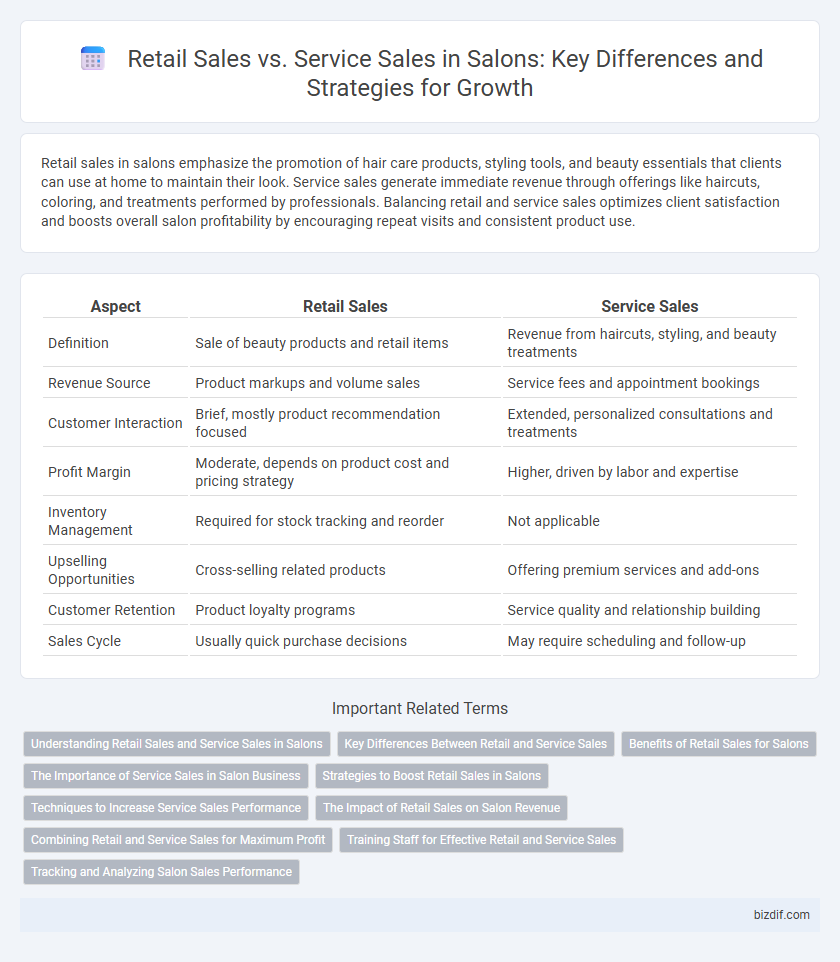Retail sales in salons emphasize the promotion of hair care products, styling tools, and beauty essentials that clients can use at home to maintain their look. Service sales generate immediate revenue through offerings like haircuts, coloring, and treatments performed by professionals. Balancing retail and service sales optimizes client satisfaction and boosts overall salon profitability by encouraging repeat visits and consistent product use.
Table of Comparison
| Aspect | Retail Sales | Service Sales |
|---|---|---|
| Definition | Sale of beauty products and retail items | Revenue from haircuts, styling, and beauty treatments |
| Revenue Source | Product markups and volume sales | Service fees and appointment bookings |
| Customer Interaction | Brief, mostly product recommendation focused | Extended, personalized consultations and treatments |
| Profit Margin | Moderate, depends on product cost and pricing strategy | Higher, driven by labor and expertise |
| Inventory Management | Required for stock tracking and reorder | Not applicable |
| Upselling Opportunities | Cross-selling related products | Offering premium services and add-ons |
| Customer Retention | Product loyalty programs | Service quality and relationship building |
| Sales Cycle | Usually quick purchase decisions | May require scheduling and follow-up |
Understanding Retail Sales and Service Sales in Salons
Retail sales in salons encompass the direct sale of products such as shampoos, conditioners, and styling tools to clients, enhancing overall revenue beyond service appointments. Service sales involve revenue generated from salon treatments including haircuts, coloring, and spa services, representing the core business activities. A balanced focus on both retail and service sales optimizes profitability by encouraging client retention and increasing average transaction value.
Key Differences Between Retail and Service Sales
Retail sales in salons involve the direct sale of physical products like shampoos, conditioners, and styling tools, providing immediate inventory turnover and tangible customer value. Service sales focus on offering personalized treatments such as haircuts, coloring, and spa services, relying on expertise and customer experience for revenue generation. Key differences include product tangibility, sales process duration, and customer interaction, with retail emphasizing product knowledge and service sales prioritizing skillful execution.
Benefits of Retail Sales for Salons
Retail sales in salons provide a significant revenue stream by offering clients professional hair care and beauty products for at-home use, enhancing client satisfaction and loyalty. These sales boost profit margins as products often have higher markups compared to service fees, contributing to overall business growth. Moreover, retail offerings educate clients on maintaining salon results, encouraging repeat visits and elevating the salon's brand reputation.
The Importance of Service Sales in Salon Business
Service sales in the salon business generate higher profit margins compared to retail sales, driving consistent revenue through repeat client visits. Prioritizing service sales enhances customer loyalty and personalized experiences, which are critical for long-term business growth. Investing in skilled professionals and tailored service packages maximizes client satisfaction and boosts overall salon profitability.
Strategies to Boost Retail Sales in Salons
To boost retail sales in salons, focus on product knowledge training for staff, enabling them to recommend personalized products aligned with clients' needs. Implementing attractive product displays and bundling services with retail items encourages clients to purchase after their treatments. Leveraging loyalty programs and exclusive promotions creates incentives for repeat purchases, increasing overall retail revenue alongside service sales.
Techniques to Increase Service Sales Performance
Implement targeted upselling techniques by training staff to recommend complementary services tailored to client needs, enhancing overall service value. Utilize personalized consultations to identify opportunities for premium or add-on treatments, boosting customer satisfaction and repeat visits. Implement booking incentives and loyalty programs specifically for service sales to encourage clients to prioritize salon services over retail product purchases.
The Impact of Retail Sales on Salon Revenue
Retail sales significantly enhance salon revenue by providing a consistent income stream beyond service appointments. Products such as shampoos, conditioners, and styling tools increase customer retention and boost overall profitability. Effective retail strategies can contribute up to 30% of total salon income, making product sales a critical factor in financial success.
Combining Retail and Service Sales for Maximum Profit
Combining retail and service sales in salons significantly boosts overall profitability by creating multiple revenue streams. Offering personalized product recommendations alongside expert services enhances customer satisfaction and encourages repeat purchases. Integrating retail products with service packages leverages client trust, increases average transaction value, and maximizes salon revenue growth.
Training Staff for Effective Retail and Service Sales
Training staff in salons to excel in both retail and service sales significantly boosts overall revenue and client satisfaction. Emphasizing product knowledge and personalized service enables employees to recommend appropriate retail items that complement services, increasing average transaction value. Consistent skills development in consultative selling and client engagement fosters repeat visits and builds long-term loyalty.
Tracking and Analyzing Salon Sales Performance
Tracking retail sales and service sales separately enables salons to identify high-performing products and treatments, optimizing inventory and staff schedules. Analyzing sales data through point-of-sale systems and salon management software provides insights into customer preferences, peak times, and revenue trends. This targeted approach enhances decision-making, boosting profitability and customer satisfaction.
Retail Sales vs Service Sales Infographic

 bizdif.com
bizdif.com